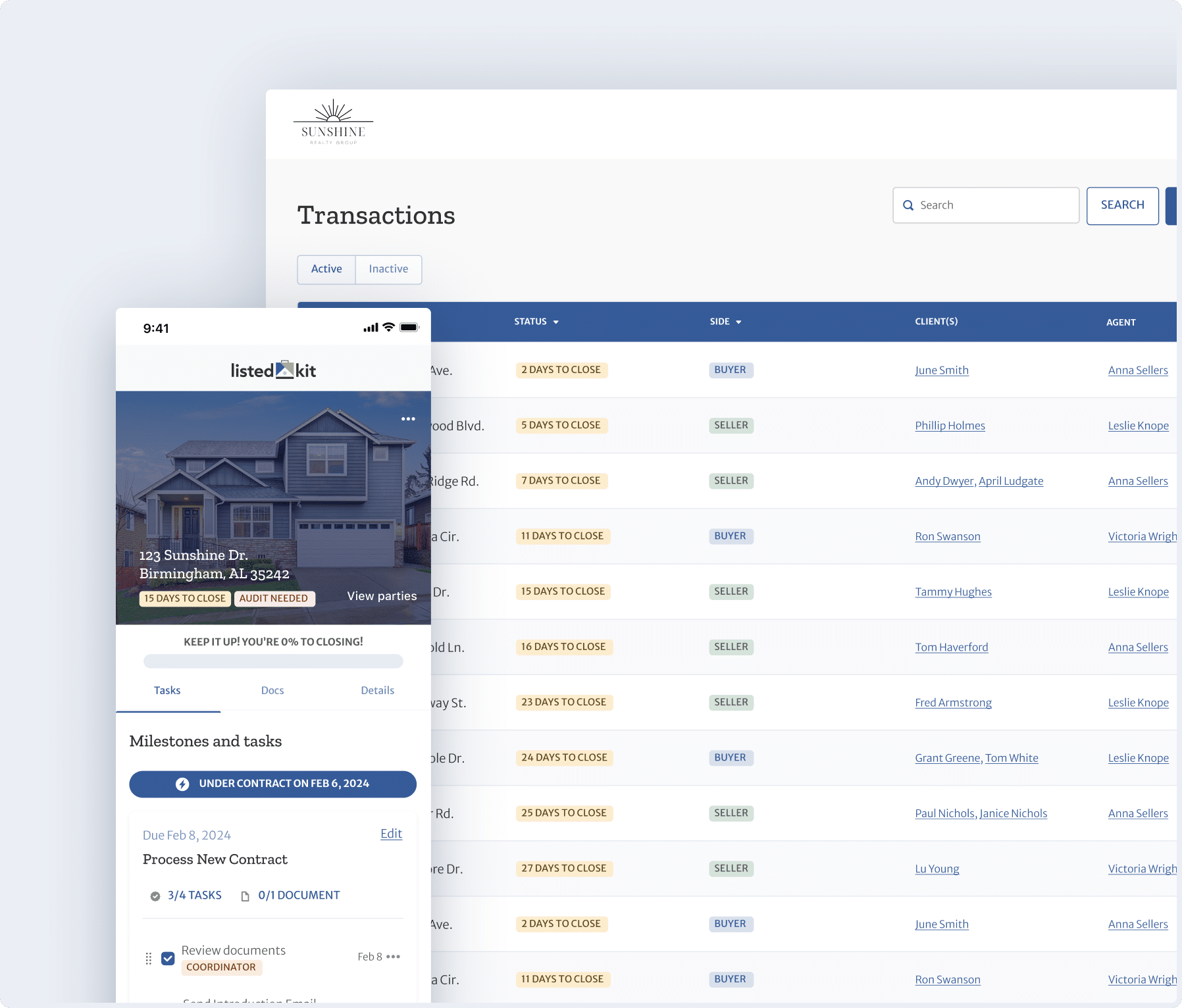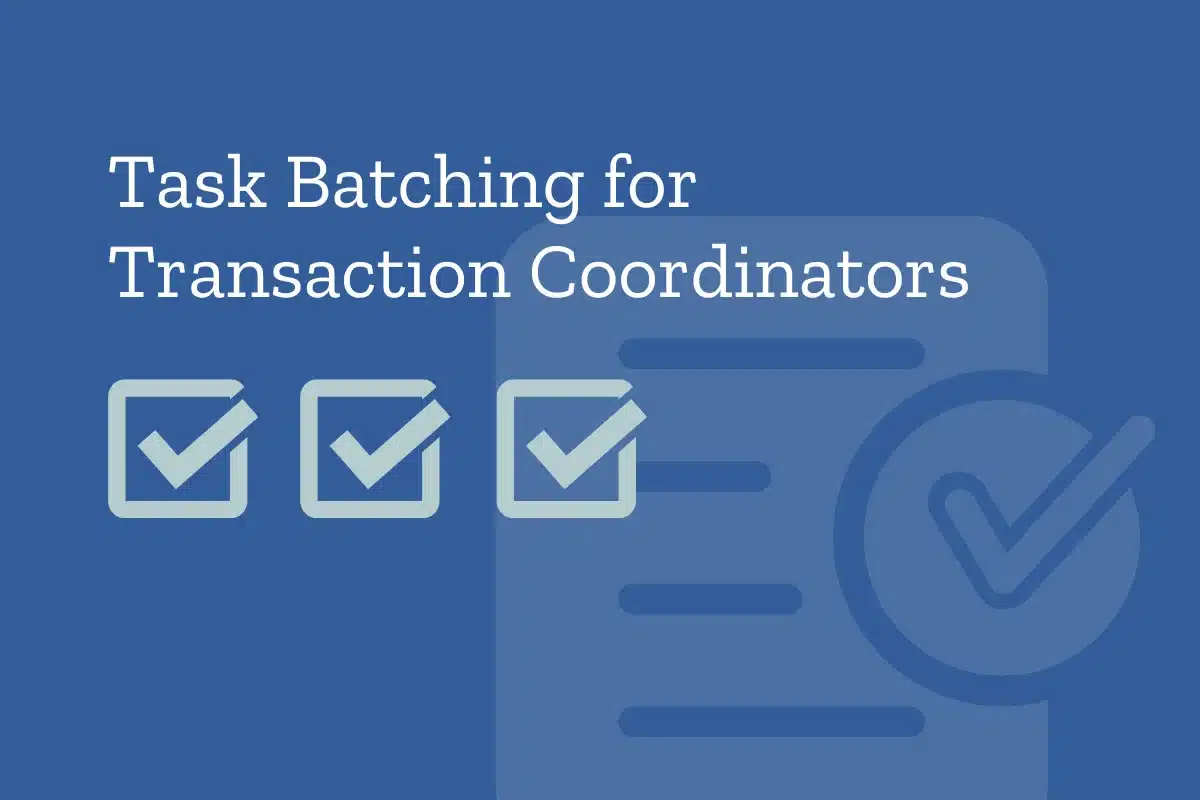As a transaction coordinator, you know that every day there are a lot of different client questions, paperwork, and status updates—pretty much all of which need to have keen attention to detail. Juggling priorities and flipping back and forth between tasks continuously generates feelings of overwhelm and mistakes, which makes workload management tough and important.
Task batching allows TCs, in the quest to create an efficient day, to group similar tasks together in blocks of dedicated time.
This article will provide actionable steps to help you integrate task batching into your routine as a transaction coordinator. We’ll focus on how to organize, prioritize, and batch tasks specific to transaction coordination in order to make each day more manageable and productive.
What is Task Batching?
Task batching is a technique in which similar tasks are grouped and completed within specified time blocks.
Instead of experiencing novel tasks in incoming order or switching between unrelated tasks, the TCs can commit uninterruptible blocks of time to given activities, such as client communications, reviewing a contract, or making status updates. Working on only one category at any given time reduces the cognitive load and constant task-switching—a major cause of inefficiency.
Task batching is very helpful for time management, enhancing concentration, and reducing errors. Here’s how task batching can become a real savior for the TCs in the real estate industry:
- Minimizes disruption: Focused time blocks help or allow the TCs to avoid unnecessary interruptions, hence being more productive.
- Boosts accuracy: Handling similar tasks all in one go minimizes the likelihood of overlooking critical details in contracts or documents.
- Improves energy management: Batching allows one to put their energies in the right direction instead of spending them on an energy-intensive task like “switching through.”
Why Task Batching is Ideal for Transaction Coordinators
Transaction coordinators handle day-to-day tasks, a process that involves everything from deadlines and follow-ups to updates with both clients and real estate agents. Here are some of the major advantages of task batching for TCs:
- Effective Time Management: Time slots will be utilized effectively because of the time-specific batches of tasks, helping coordinators manage their time better.
- Reduced Task-Switching: Fewer transitions from one unrelated task to another result in greater focus and lower fatigue.
- Improved Client Satisfaction: More consistent and uninterrupted attention to client interactions means no detail goes unnoticed, thus improving client satisfaction.
- Smoother Work-Life Balance: By reducing the chaos of managing several tasks, TCs can bring order to a work environment that reduces the occurrence of burnout and allows for better work-life balance.
To further simplify transaction coordination and effective time management, TCs might want to explore ListedKit, a tool for helping real estate professionals organize their tasks in one user-friendly platform.

Key Areas of Task Batching for Transaction Coordinators
To make task batching a core part of your workload management, follow these actionable steps designed specifically for transaction coordination. Each step offers detailed advice on maximizing batching’s efficiency and ensuring it aligns with your unique responsibilities.
Step 1: Identify and List Out Core Responsibilities and Tasks
The first step in effective batching is to take stock of everything you handle regularly. This involves creating a comprehensive list of your day-to-day tasks to understand what needs to be managed. In real estate transaction coordination, these tasks typically include:
- Client Communication: Managing emails, responding to phone calls, and updating clients on the status of their transactions.
- Document Review: Reviewing contracts, disclosures, and compliance paperwork to ensure accuracy and legal adherence.
- Administrative Maintenance: Updating internal systems, entering data, scheduling inspections, and filing.
- Status Updates for Stakeholders: Providing timely updates to real estate agents, clients, lenders, and other parties.
By categorizing your workload into these essential areas, you can spot where task batching would be most impactful. This list will be a foundation for planning and grouping tasks into effective batches.
Step 2: Group Similar Tasks into Categories for Batching
Once you’ve listed your tasks, organize them into groups based on similarity and relevance. These categories will form the basis of your task batches. For transaction coordinators, consider organizing tasks into batches such as:
- Client Updates and Communications: Responding to client inquiries, providing transaction updates, and addressing pending issues.
- Document Processing and Review: Conducting contract reviews, verifying documents, and ensuring compliance with regulations.
- Routine Administrative Tasks: Updating CRM tools, scheduling appointments, and managing paperwork.
- Stakeholder Updates: Check in with real estate agents and keep all stakeholders informed.
By creating these distinct categories, you’re setting yourself up for efficient batching. Each batch can now be assigned to specific time blocks without overlap, helping you focus on one task at a time.
Step 3: Prioritize Each Batch According to Impact and Urgency
Not all tasks hold the same priority, and as a TC, you know certain tasks demand immediate attention. Start by identifying the high-priority tasks within each batch. For instance:
- High-Priority Tasks: Legal document reviews, client calls involving critical updates, and contract deadlines.
- Medium-Priority Tasks: Routine communications and status updates.
- Low-Priority Tasks: System updates or minor administrative work that can be done during slower times.
Prioritizing batches allows you to tackle the most critical tasks during peak productivity hours and handle lower-priority batches when your energy or focus dips. This structure helps keep high-stakes work from overlapping with routine tasks, ensuring consistent accuracy and a balanced workload.
Check out ListedKit’s webinar on optimizing transaction coordination to gain deeper insights into task batching, managing workloads, and integrating digital tools.
Step 4: Set Up Dedicated Time Blocks for Each Batch
Setting up dedicated time blocks is essential to keep your task batching method disciplined and effective. When planning your time blocks, consider your energy levels, typical client demand hours, and when you’re least likely to be interrupted. For instance:
- Morning: Use this time for detail-heavy tasks such as document review, contract checks, and compliance updates, as mornings are typically when most people are at their peak focus.
- Late Morning to Early Afternoon: Allocate this period for client communication and updates. This is usually when clients are more responsive, allowing for productive exchanges without delayed responses.
- Afternoon: Set aside this time for administrative tasks and any remaining client or stakeholder updates.
Each time block should be realistic in length, ensuring you can focus on the batch without burning out. Time blocking allows you to complete each task within its designated period, minimizing the risk of interruptions and creating a predictable rhythm for your day.
Step 5: Leverage Digital Tools to Support Your Batching System
Digital tools can streamline task batching significantly, especially for transaction coordinators handling multiple client interactions and document requirements. Consider the following tools and how they can enhance your batching process:
- Project Management Software: Platforms like Asana help you assign tasks to specific batches and track daily progress.
- Customer Relationship Management (CRM) Tools: CRM tools centralize all client communications and updates, making it easier to manage client batches efficiently. With these tools, you can prioritize client interactions and ensure each communication aligns with your set time blocks.
- Management Software: Document collection and management platforms enable you to organize and process documents in batches, ensuring no contract or form is overlooked.
For transaction coordinators looking to streamline further, ListedKit offers an all-in-one solution for managing client interactions, contracts, and scheduling within a single platform. This is particularly helpful for efficient task batching and workload management.
Step 6: Monitor Progress and Adjust Batches as Necessary
Implementing task batching is a process, and it may require a few adjustments to fine-tune. After your first few weeks, assess what’s working well and identify any bottlenecks. Here are some indicators and questions to guide your evaluation:
- Time Tracking: Are specific batches consistently taking longer than expected? Consider shortening overly lengthy time blocks or dividing complex tasks into smaller batches.
- Client and Stakeholder Feedback: Has batching improved the speed and quality of client communications? Collect feedback on response times and communication effectiveness, as these are key indicators of batching success.
- Workload Balance: Are certain tasks still creating stress despite batching? Adjust your prioritization system, consider reallocating less essential tasks to slower periods, or even delegate them.
Make adjustments based on these evaluations to continuously optimize your batching system. Effective batching should streamline your workflow, reduce stress, and enhance your productivity without sacrificing the quality of your work.
Best Practices for Task Batching Success
To make task batching work best for you, consider these practical tips:
- Use a timer: Setting a timer for each batch can keep you on track and prevent overworking on a single task.
- Take 5-minute breaks: Short breaks between batches can help recharge your mental energy, ensuring you stay productive throughout the day.
- Delegate when possible: If you can access a virtual assistant, consider delegating repetitive tasks to free up more time for high-priority work.
- Communicate your schedule: Let your clients and agents know when to expect updates, allowing them to respect your batching schedule.
- Set realistic goals: Task batching should simplify your workflow, not overwhelm you with strict time frames. Ensure that the goals for each batch are achievable within the allocated time.
Overcoming Common Task-Batching Challenges
Although task batching can significantly improve workflow, it may pose some challenges:
- Difficulty Sticking to Time Blocks: It can be tempting to extend a time block if you’re in the middle of a task. Use a job scheduler to keep yourself accountable to the time block.
- Adjusting to Unexpected Changes: Real estate transactions can be unpredictable, with urgent tasks often cropping up. In these cases, designate a “catch-up” batch at the end of the day to handle anything that couldn’t be managed within its original block.
- Mental Fatigue from Long Batches: If certain tasks require intense concentration, consider breaking them into smaller batches to prevent burnout.
Measuring the Success of Your Task Batching System
It’s essential to regularly assess whether task batching is helping you manage your workload more effectively. Track key metrics such as:
- Client Satisfaction: Use client feedback to see if there’s an improvement in client satisfaction due to more organized and consistent communication.
- Productivity Levels: Monitor your workload completion rate and any reductions in errors or missed deadlines.
- Stress Levels: Pay attention to your overall well-being. If batching tasks has reduced stress, you’re likely on the right track.
Conclusion: Mastering Workload Management with Task Batching
For real estate transaction coordinators, mastering workload management is critical to ensuring smooth transactions and maintaining client satisfaction. Task batching provides a structured approach to handling daily tasks, reducing stress, and improving efficiency and accuracy. By implementing a system of task batching, TCs can streamline their operations, foster stronger client connections, and achieve a higher level of professional satisfaction.
This method offers transaction coordinators a practical, results-oriented way to improve time management and manage the unique demands of their role within the real estate industry.
With a few adjustments, such as adopting a real estate transaction management tool like ListedKit or a project management tool and setting realistic goals, TCs can build a more sustainable and productive workflow that supports their well-being and the satisfaction of their clients.




